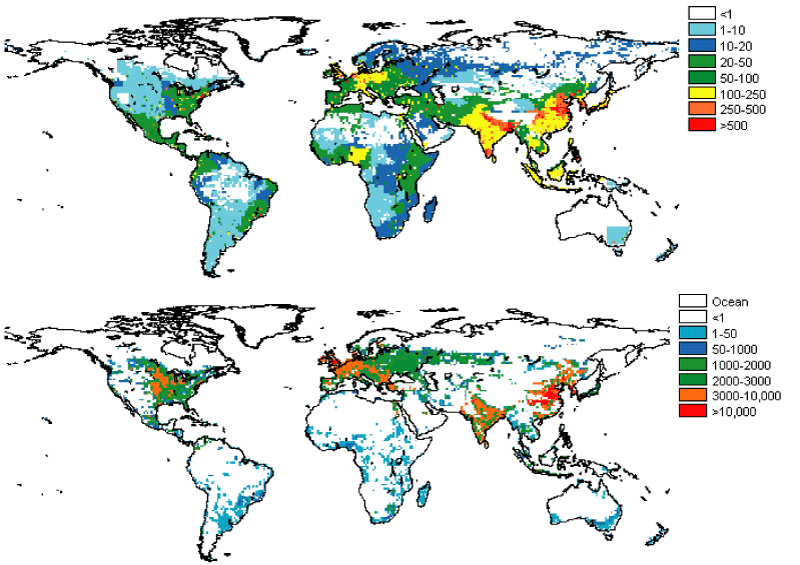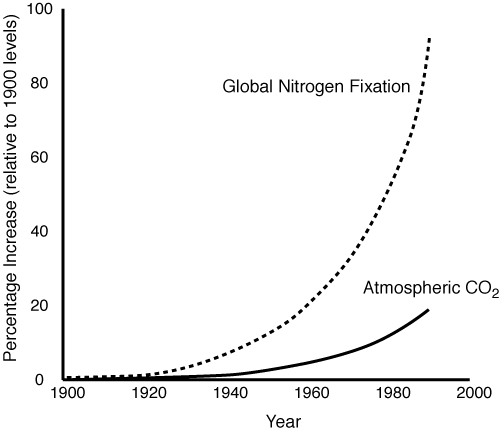


 |  |  | 17.1 History |
Cultural eutrophication is old as Homo sapiens. In particular after the introduction of agriculture and larger settlements eutrophication has been mans faithful companion. During the pre-agricultural hunting and picking stage only probably a couple million humans inhabited the world and cultural eutrophication was negligible. The 3 orders of magnitude increase in population has changed this considerably. Human population growth and mans present existence is entirely based upon the development and efficiency of agriculture. Seafood delivers only a small percentage of human food word wide. A consequence of the increased population (based on agriculture) has been large-scale cultural eutrophication. This process has accompanied all major civilisations. Mesopotamia, the Golden Crescent, the Mediterranean cultures, central Europe, North America and China all have been affected/suffer from the effects of cultural eutrophication. Some of us may dream about the good old times of the Middle ages when man lived closer to nature, when the word appeared to be `greener' then today and when life was more `natural'. This view is based on a misunderstanding. The present eutrophication of the Baltic and North Sea was preceded by similar or even worse eutrophication periods caused by logging and the introduction of large-scale agriculture in Europe. Medieval cities were probably not only unsanitary, but contaminated by organic waste, nutrients and heavy metals. The cultural eutrophication in major cities must have been immense, far beyond today's imagination. A good example of the ambience of Paris in medieval times is portrayed in Patrick Suesskinds novel `Perfume'. Cultural eutrophication is thus not a recent phenomenon. It has continuously accompanied mans existence in variable degrees. Locally cultural eutrophication can have been far more significant than today.

The earth's recent development is characterised by accelerating population growth, human migration and immigration patterns (Fig. 5.1), modern agriculture and fundamental changes in nutrient and water cycles. Cultural eutrophication has become a global issue, in particular due to interference with the local and regional nutrient and water cycles. Substantial amounts of nutrients are discharged into rivers, lakes and estuaries (Figure 1). They reach the ocean more and more rapidly. Eutrophication is thus, in general, highest in the estuaries as nutrient concentration population density increases likewise increases along the rivers pathway from the interior to the coastal zone (Fig. 5.1).
Many industrialised countries import not only fertilisers but also nutrients in the form of food. Often they even import the limited resource water in the form of food. For example, 1 kg of wheat demands 1 m3 of water; 1 kg of rice needs 2 m3 of water while 1 kg of beef requires 10 m3 of water. Densely populated countries that have the financial means to buy food from outside, e.g. the Netherlands with plenty of water, is a large-scale importer of water. Thus not only nutrients and biomass are moved over long distances, connections between otherwise separated ecosystem, biogeochemical cycles and resource-limited societies are established. Many of the most developed countries are net-importers of nutrients, in particular nitrogen. The nitrogen supply can be several times greater than the natural standing stock, and that inevitably results in eutrophication. Resources from obviously resource-limited regions (food, water, and fertilisers) are deviated into resource-rich ones. However, here they can cause large-scale eutrophication.
The focal point of cultural eutrophication is the fundamental changes in cycling of carbon, nutrients and water. The recirculation inside small region that was characteristic for the ecological setting in earlier days when the means of transportation were limited, is changed and the nutrient and water circles are first opened (i.e. the natural space and times scales are exceeded) and subsequently widened to global scales. Due to this the biogeochemical cycles are significantly changed. Stored carbon (coal, oil, gas, wood, soil) are reassigned with the consequence that the atmospheric CO2 concentration has increased from 240 to 380 ppm since the industrial revolution (Figure 2). We move phosphorus in the form of apatite from the Kola Peninsula to cover the words needs for phosphorous. We fix nitrogen gas from the atmosphere in similar amounts than nitrogen fixers. We dam and channel rivers, change their discharge patterns and focus sewage into sewers. By fracturing existing biogeochemical and water cycles we change the original cycling, introducing a new, global cycling pattern that changes the overall functioning of the globe. Despite that nutrient discharge can be minimised by effective management in the drainage area, losses inevitably occur. Human population growth, altering global biogeochemical cycles, and increased eutrophication are therefore two aspects of the same cause.

 |  |  | 17.1 History |